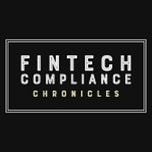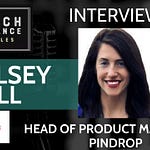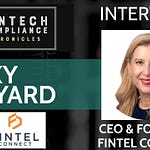(Note - all views are those of Fintech Compliance Chronicles/my personal views and not affiliated with any other organization)
(Additional Note - We will be hosting a breakfast-hour event during #NYFintechWeek on April 22! Spots are filling up quickly, learn more and sign up here.)
Continuing our series from Fintech Meetup 2025, with more great conversations with trailblazers and innovators on the topic of compliance. This week I’m featuring my discussion with two fantastic leaders from BankTech Ventures - Pam Kaur, Head of Bank Technology, and Katie Quilligan, Investor.
BankTech is “a strategic investment fund that was founded to support the community banking industry. Our mission is to generate both strategic value and financial returns for our investors. We accomplish this by sourcing, vetting, investing in, and introducing best-in-class bank-enabling technology solutions that enhance the competitive positions of our community bank partners. Backed by a seasoned investment team and General Partners from the community banking industry (including two of the nation’s most innovative community banks), we believe that BankTech Ventures is uniquely positioned to accomplish this mission.”
Some background about Pam: “Pam Kaur is the Head of Bank Technology at BankTech Ventures, where she supports the fund's rapidly growing portfolio of fintechs and limited partner banks. She plays a key role in both pre-investment diligence and post-investment activities, guiding fintechs on aligning their solutions with community bank needs and helping banks navigate their digital transformation journeys. Pam's efforts ensure a seamless onboarding experience, from sourcing fintech solutions to implementation, helping mitigate risks and drive success during hyper-growth stages. Before joining BankTech, Pam was VP of IT at a $5B+ community bank in California. She holds a BS in Computer Science from the University of the Pacific and an MS in IT Management from Golden Gate University. Pam currently resides in the Greater Sacramento, CA area and enjoys experimenting with new recipes, reading, and exploring local trails.”
Some background about Katie: “Katie works on the investment team, finding the bank-enabling fintechs that would best serve our Limited Partner banks and the broader banking industry. She supports the investment process from origination to execution and everything in between. Katie has previous fintech investment experience at a seed stage fund, as well as a track record of driving audience growth, revenue, and innovation for startups and Fortune 500 companies, including American Express.”
Although we didn't get a chance to dive into it during our conversation, I would be remiss if I didn't shout out their other venture Tech Sis, a fantastic initiative devoted to amplifying the voices and journeys of women in tech/fintech. It’s 2025 and tech and finance are still pretty male-centric, which is why we here at Fintech Compliance Chronicles are proud to support efforts like Tech Sis that are actively working to change the face of the industry.
It’s not every day you get to hear directly from the people writing the checks and thinking through the regulatory minefield. What stood out in our conversation was how deeply compliance is baked into BankTech’s thought process, from beginning to post-investment. Hearing Pam and Katie talk through how they evaluate and support fintechs gave me a whole new appreciation for the role investment funds can play in shaping the ecosystem. Thank you yet again to Caliber for setting up the discussion and to both Pam and Katie for making the time! The transcript of our discussion is below and the recording is at the beginning - enjoy:
Zarik: Who are you? What do you do?
Pam: Yeah. I'll start with BankTech. So we're a strategic investment fund. Backed by over a hundred community banks across the us. We invest in bank enabling FinTech companies. I've made 22 investments to date over the past three years.
I am Pam. I work on the post investment side as our head of bank technology. So I do all of our portfolios support, post-investment, and help our companies, one, help them figure out how to work together easier with banks. Two, help them figure out their product market fits their literally A through Z of anything that they need to actually work with a bank.
One of the major things that we do is take them through this banker style due diligence process. So they really get that crucial lens on their company of how a bank will evaluate them.
Zarik: I saw that you do audits essentially of their tech stack.
Pam: Essentially, yes. So similarly to when a bank is onboarding them as a potential vendor or some kind of partner with them, we'd also take them through this process, One, to make sure that they understand what that process is gonna look like. Two, to help them find any gaps that they might have there.
And then three, obviously help them figure out where we can plug in things for them to help build out that program long term.
Zarik: Do you have any relationships that you're able to pass along to from your perspective like, "Hey, you may want to connect with these parties", or is it more like you prepare them and then, after the fact, they're on their own? Describe to me, beyond your portfolio company, if you will the role in helping them in relationship management?
Pam: Yeah, so we definitely have a short list of partners and third party vendors and other things that we have formed our own relationships with that will either send them off to like here's a compliance lawyer, or here's somebody that offers like Chief Compliance Officer as a service to your company, or, here's somebody else in the ecosystem that is going through the same thing as you, what they did, and you can figure out next steps. It really depends on the company, what stage they're at. What their comfort level is to even, ask for help. But we are more than happy to help provide any services. I'm happy to help walk them through that myself with any of my own experience in banking in the past, and guide them through, here's how a bank might look at this, or here's why this is okay for right now because you're an earlier stage company and we don't expect you to have x, y, Z built out, and here's how you can talk to the bank about why you are where you are. So it just varies based on the company.
Zarik: Got it. Katie?
Katie: So I'm on the investment side of the team, and that means that we're going out and sourcing companies and trying to find the best solutions that will help make our banks continue to be innovative, competitive.
A lot of the diligence that we do, mirrors what a diligence process might look like at a bank. At other more traditional funds, it's probably a lot lighter. We're putting them through a lot more diligence and also a lot of what we do is looking through the lens of how can a bank actually use this?
And thinking from that customer lens, as well as evaluating what kind of financial returns and other things that we can get, really dual lens, I would say a big part of the value we provide to our limited partners is this market intelligence. If we're meeting so many companies, we're seeing what's out there and going back to them and saying, here's kinda what we're seeing in the market.
This is what you should be looking at, thinking about for your future and making introductions. Even the case we're not making investments. There might be a solution that a bank needs, where we can make that and facilitate that. So they're getting a lot of value beyond just financial returns from saying yes to investing in our fund.
Zarik: Got it. And so maybe just shifting to the angle that I love to talk about which is compliance. You mentioned the audits briefly, from either of your sides or both of your sides, do you have a methodology around compliance when you are evaluating an organization for fit.
I know you've talked about auditing and reviewing, but from your perspective how do you think about that when you're looking at prospective companies?
Katie: Well, one, we have the benefit of having Pam on our team, so as part of our diligence process, we'll bring her into the calls because she has the expertise of having worked at a bank.
And I think a lot of what we'll ask them is about different things, like, let's say generative AI, right? How is that data being used? Is it going to be shared? Let's talk through some of those, just depending on what the solution is, there might be different sets of questions that we're looking at.
But we are trying to do it from the frame of, "what would a bank be concerned about here and how can they evaluate that?" We look at third party risk management solutions for potentially investing and for our banks to use. But we've also looked from the side of, "Are there tools we should be using to be getting smarter and better in this area?" To go to that extra level of thinking and making sure that everything is intact, we have a pretty extensive list of the documents and things that we ask them for ahead of time.
Zarik: Pam back to you, when you're thinking about all the talk around third party risk management, BaaS, FinTech - bank partnerships, how do you see that in 2025 and beyond with the shifts in the regulatory environment?
Like do you think that anyone out there in DC is even thinking about this anymore?
Pam: Yeah. I actually just did a webinar on this last week. A lot of the conversations that I've heard from FinTech lawyers or people in DC that are either lobbying or doing something in the space to try to figure out like what's next for banks, and advice that we've also gotten from some of these experts in the industry have been, "a lot of what is already out there in terms of regulation is not gonna change very quickly."
The conversation that we had last week with the American FinTech Council talked about how much time it'll actually take for it to go from up here down to the actual examination level and actually changing at the per bank level and how your own banks examiner might either decide to ignore certain things or decide, " this is the way I've been examining for 25 years and these are the things that I care about and it's still gonna be the things that I care about." . Just in terms of like safety and soundness, we don't think that will change very quickly.
These people that have been working there as career examiners, have gone through many administrative changes and have had many different presidents, et cetera. Agency heads tell them different things. But I think, "As we are humans, this is what we care about and these are the things that we're gonna examine," I don't see that changing very quickly. I might be wrong, but hopefully I'm not. 'cause I think that would bring a lot of instability into how, banks. Are safe and sound. You know, we've seen banking crises in the past. And, I think some of these things that came out in the last 10, 15 years were to help prevent additional crises like that. So I don't foresee a lot of things changing very quickly at the per bank examination level. I think it takes time for that messaging and communication to get down. All the way down from executive to examiner. So I think there's gonna be a little bit of a lag there. Again, it's very unprecedented times in terms of, regulation and things.
I think for sure there won't be any new regulations coming out very quickly. A lot of existing things that have been in the air over the last one to three years are, again, a big question mark of which of these are still going to be existing at the end of the year, or even by summertime.
But I think the, at the bank level, the banks still need to make sure that they're acting in a manner that is beneficial to their customers and keeping their customers money and things safe. So I think at a core level, I don't see that changing very significantly. I think for sure, new regulation is gonna be neither here nor there. We don't know. Administratively we're at a huge pendulum shift this way. Again, in four years, three, four years, it might swing right back the other way or somewhere in the middle. So I think people that are doing these jobs day to day understand that and are hopefully not trying to get swept away in the "Oh no. Everything's changing now."
Zarik: Yeah. And I think there was similar talk in 2016 and if anything the focus was on larger institutions getting hit even harder. So, who knows what the future will hold, to some extent.
I wanted to circle to AI. From the compliance angle, one topic that I've been having some conversations about is like AI in fairness of evaluations of customers and that sort of thing. So I'm curious, what are some positive developments, any examples that you've seen about companies that have used AI to really solve issues of fairness or from a credit perspective, any stories of companies doing it right and solving some of the problems around lending using AI in a compliant fashion. Maybe that's kind of a unicorn, who knows but, would love to get your take on that.
Pam: Yeah. Katie's actually our AI, bank tech AI expert so I don't know if you wanna add anything on that specifically. We've definitely seen companies specifically working with fairness and how AI is gonna play into that in the lending space., I don't know that banks have been super quick to adopt solutions like that as of yet.
I think, again, it's a big regulatory question mark, so, it's been a little slow play of, let's see how it goes. I think the larger institutions are more likely to engage in those types of conversations.
Zarik: It's the large institutions that many would argue, need to be disrupted.
They've kind of created the problem, right? Of, folks getting shut out of the system.
Katie: Yeah. We talk to our banks about what they're using, a i for, it's mostly back office, compliance and creating the efficiency piece because they are worried about this regulatory piece. So thinking about fair lending or how they just don't even wanna get swept up into that, even though we believe that there's so much possibility for loan volume to be done faster, more efficiently, and potentially helping, like on the s and b side, if you can now do these smaller dollar loans and do them as efficiently as you can, these larger loans, then you're gonna say yes to them.
Whereas before you only had the bandwidth, the resources to do these larger ones. So you're gonna say no, but then it does bring into what you're talking about of, where's the fairness come in and understanding the data that's going into the model that you're creating. So we've spent time looking at, is model risk management now going to be more something that our banks need to bring on?
And so is that a standalone tool where the banks need to do this and be doing it and they'll have a lot more models coming in because they have technology to do things? Or is it something where we say yes to a lending solution that has MRM built into it? And so each individual tool has its own safety guard around it.
The ones that I think are probably being smartest about doing some of this and evaluating the models and keeping them in check are using some form of generative ai, but then also using that traditional machine learning and creating so that they're testing their model. In some ways it's keeping it in check because it's deterministic. So you can say is this a yes or no? And if there's red flags, you can then come and check them. But I think it's just, that, that loan space is just tricky right now. And it's hard, especially for the larger banks, they have such large volume.
I think that a lot of the companies are using data sets from these larger companies and larger swaths. So then when they're doing their loans, they actually can mimic more what the larger banks are seeing at these smaller institutions. The models and what's being created may not actually mimic their customer set.
And they may not have enough volume in what they've done historically to do that. And so we have to look into things like creating synthetic data. And then to your point, you get into that, like, how do we think about creating fairness in this? Or are we just creating synthetic data on top of, historically, that data and I honestly think the answer has been, we just don't wanna deal with that right now. Or, it's just not going to be the first place we go to for ai, which is not a very satisfying answer. But that's where we are. It just hasn't been a top priority.
And I don't think until there's really clear ROI and also clarity on what's regulation gonna look like for using AI to do underwriting, that there's going to be a large take. But what I do think is that the companies who are using underwriting, they need to build in their own version of model risk management into it.
And that they need to assure them and create some really easy ways for the bank to talk to the regulator about, this is what we're using, this is how we're getting our data, and helping them have the conversation and put it into really approachable terminology. And clearly explain that they understand the data that's going in, the data that's coming out.
And that's, I think what we spend a lot of our time evaluating and also talking to our companies about, how do you help empower the bank to have these conversations so that the regulator can say yes to it.
I would say one of our banks that has been in the forefront of adopting AI solutions and specifically generative AI solutions, has really gone back and looked at their third party risk management and continued to add additional questions and depth to what they're doing. To them this is still evaluating solutions. "We know how to do this and so let's put this in our framework, but just develop it into a stronger way." And I think that also makes it more approachable for banks. They have the capability to do this, they just need to dig in deeper, in the right spaces.
And that might mean now adding, again, like model risk management becomes part of that conversation more than it had been previously or just bringing in other parts. But I do think it's still part of that same process of just making it larger and expanding on that.
Zarik: Yeah, I just, I heard model governance. I rarely hear that term as a compliance person. You want to hear more of that. Closing on a somewhat lighter note. You mentioned American FinTech Council, so my understanding is there's a partnership that has recently been established. So, maybe just talk a little bit about that and some of the advantages you could see, especially from a compliance perspective in terms of how you're dealing with companies, your partners, et cetera and just for the organization in general BankTech.
Pam: Yeah. I think that was a partnership long in the making needed to happen a long time ago. We've been very close with them for a while. I think we have a lot of strategic alignment both on the bank and FinTech side. Of course, they represent both banks and fintechs.
For us it's great to be able to keep a pulse on, what are some of the regulations and things coming down the pipeline, what side are we standing on and how can we help support that? And how do we communicate those back down to the fintechs and banks that we work with as well? 'cause that's obviously a big part of us as our strategic investor. For both the FinTech and bank side is that we help 'em figure out and navigate this space. Right? So that's been a great pulse check for us in DC and just at the state level as well. And I think great for our portfolio companies to be able to connect into that and help have a voice of what they think regulation should be and how certain regulations impact them.
And again, what side should they stand on, same for the banks. We help them keep a pulse on the ecosystem, on FinTech, on BaaS, on regulation.
So I think we, we will have a great opportunity to work very closely with American FinTech Council on some of those things, like, here's what we're hearing on the bank side and here's what we're hearing on the FinTech side, and being able to collaborate and help create unified messaging for the entire ecosystem based on that.
Zarik: And that was the end of our conversation. I want to thank Pam and Katie for their time and for an insightful and fun conversation. Thanks for joining us on another edition of FinTech Compliance Chronicles podcast.













Share this post